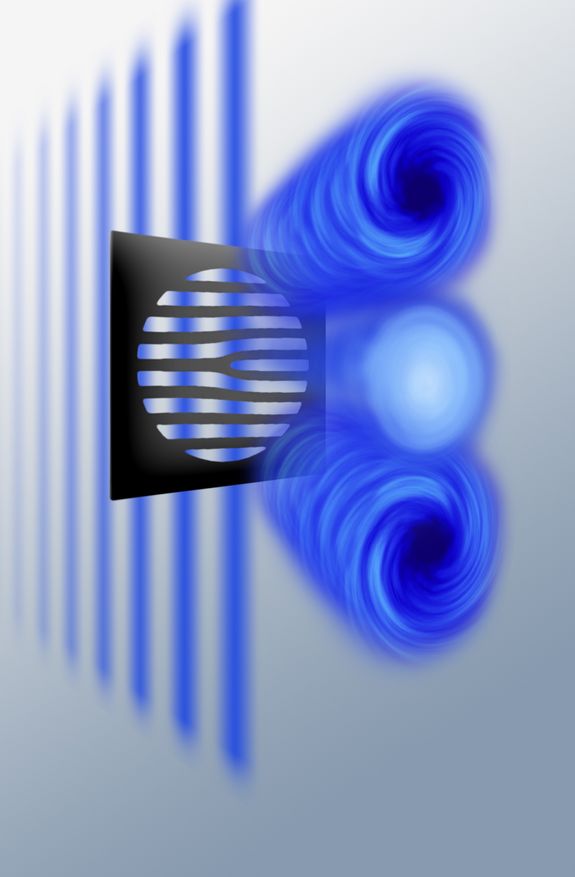Manipulating materials with rotating quantum particles: a team from the University of Antwerp and TU Vienna (Professor Peter Schattschneider, Institute of Solid State Physics) has succeeded in producing what are known as vortex beams: rotating electron beams, which make it possible to investigate the magnetic properties of materials. In the future, it may even be possible to manipulate the tiniest components in a targeted manner and set them in rotation. The physicists report on this breakthrough in electron physics and its application in the current edition of "Nature".
Rotating current: the quantum tornado
Electron beams have been used to analyse materials for some time now – for example in electron microscopes. For the most part, the beams' rotation does not affect this analysis. In classical physics, an electron current in a vacuum does not have any orbital angular momentum. In quantum mechanics, however, the electrons must be envisaged as a wavelike current – which can rotate as a whole about its propagation direction, similar to the air flow in a tornado.
Vortex light beams have been used in optics for some time (for example, as optical tweezers for manipulating small particles). Vortex beams made from electrons also offer many new possibilities for managing nanoparticles or measuring angular momentum-related parameters. However, there were previously no really efficient methods of producing them. "When I was working on an idea of how these beams could be technically produced, it emerged that colleagues from Antwerp had had the same idea", explains Prof Schattschneider. "We therefore decided to pursue the project together: Antwerp had progressed further with the production and Vienna came up with a suggestion for the first application."
The trick with the screen
The production of vortex electron beams was made possible with the help of a grid-like screen cut from platinum foil. When it passes through the platinum screen, the electron beam is diffracted in a similar way to light beams when they pass through a fine grid. The shape of this screen, which measures only a few millionths of a metre, was specifically calculated so that a flat incident electron wave is converted into vortex beams. Right-rotating and left-rotating vortex beams are thus formed behind the grid and in the middle there is a conventional electron beam that does not rotate.
If the electrons are used to irradiate a material which for its part also influences the angular momentum of the electrons, and if the electrons are subsequently directed through the made-to-measure platinum screen, then, after this, either the right-rotating or the left-rotating vortex beam will be more intense. "This enables us to investigate processes affected by angular momentum in nanomaterials much more precisely than was previously possible", explains Prof Schattschneider.
Better than science fiction
The physicist, who also occasionally writes science fiction, does not find it hard to imagine more exotic applications for the vortex beams: "These electron beams could be used in a targeted way to set tiny wheels in motion on a microscopic motor. Also, the magnetic field of the rotating electrons could be used in the tiniest length scales", Schattschneider speculates. Even applications in data transfer (quantum cryptography) and quantum computers are feasible.
| Infobox: Angular momentum In quantum mechanics, a distinction is made between the orbital angular momentum of a particle (for example, in the rotation of an electron about the nucleus of an atom) and the internal angular momentum (spin). The spin is often compared to the intrinsic rotation of a particle – similar to how the earth rotates on its own axis. Because electrons are not spherical but are rather described as punctiform and without intrinsic extension, this comparison is of only limited validity. Unlike the intrinsic rotation of the earth, which can theoretically take on any speed imaginable, the spin of an electron can only ever have one of two values. These are referred to as "Spin up" or "Spin down". The vortex beams, however, do not have their angular momentum because of the electron spin, but rather due to a spatial rotation of the particle flow about the propagation direction of the electron wave, which means it is therefore an orbital angular momentum. This means that it can have higher values than would be possible quantum mechanically for the electron spin. |
Original publication:
J. Verbeeck, H. Tian, P. Schattschneider: Production and application of electron vortex beams, Nature, 2010.
For more information, please contact:
Vienna University of Technology
Institute of Solid State Physics
Prof. Peter Schattschneider
T: +43-1-58801-13722
<link>peter.schattschneider@tuwien.ac.at

